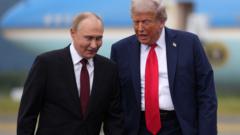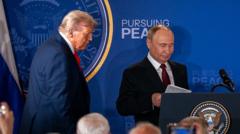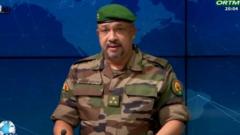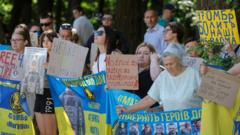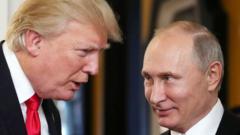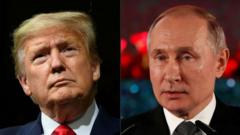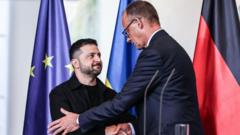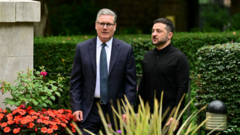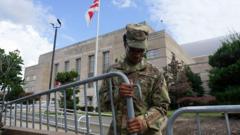The whirlwind engagements leave questions about the coherence of his strategic vision as he pivots from isolationism to a mercantilist diplomacy.
**Trump's Diplomatic Blitz: A Week of Global Engagements and Controversies**
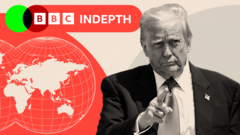
**Trump's Diplomatic Blitz: A Week of Global Engagements and Controversies**
Amidst a flurry of international activities, President Trump's recent week suggests a shift in his approach to foreign policy.
In an extraordinary diplomatic week, President Donald Trump has been actively engaging on multiple fronts, showcasing a novel approach to international relations that appears to prioritize trade over traditional conflict resolution. From the Gulf to Ukraine, the pace and breadth of his actions raise intriguing questions about his overarching foreign policy strategy.
The week kicked off with Trump’s high-profile visit to Saudi Arabia, where he advocated for a “commerce not chaos” stance, signing agreements claimed to value $600 billion in investments back to the US. This marked a clear pivot from prior Western interventionist stances as he emphasized mutual benefits from trade deals, minimizing discussions on ideological concepts such as human rights or democracy. Instead, he warned against past interventionism and positioned himself as a defender of American interests rather than a promoter of global justice.
In contrast to the assertive dealings in Saudi Arabia, Trump seemed initially hesitant to address the ongoing tensions between India and Pakistan, branding the situation as “none of our business.” This reluctance marked a departure from traditional US foreign policy, which has typically involved meditating in such conflicts. Eventually, under pressure, he engaged with both nations to encourage de-escalation, although Indian sources dismissed his role in brokering the resulting ceasefire, indicating a lack of consensus on the US's influence.
The unorthodox decision to lift sanctions on Syria and engage with its controversial president demonstrates Trump's hands-on approach to foreign policy. Although seen as bold, this maneuver caught many insiders by surprise and was viewed as yielding too much power to foreign leaders without wider governmental input—a move backed by strategic lobbying from Turkey and Saudi Arabia. However, this strategy of impulsive decisions raises concerns about consistency and effectiveness in long-term diplomatic relations.
Simultaneously, Trump negotiated a notable reduction in tariffs on Chinese goods, backtracking from recent hardline stances. Here again, critics argue that his negotiation style lacks coherence and often leads to swift shifts in policy that could undermine long-term strategies, particularly in volatile regions like Ukraine, where military tensions continue.
Another key development was Trump’s ceasefire agreement with Houthi fighters in Yemen, a move described by some as a response to his reluctance to engage in lengthy military operations. However, these actions have allegedly sidelined traditional allies like Israel, where leaders express concern over potential shifts in US military commitments in the region.
Ultimately, Trump's frenetic diplomatic week illustrates an evolving, perhaps mercantilist, foreign policy ideology. His approach indicates a desire to recalibrate US engagement in global affairs while navigating an intricate landscape of international relationships. Yet, critics remain cautious, suggesting that while he seeks rapid resolutions to pressing conflicts, the broader implications may leave existing tensions unresolved. The outcome of this diplomatic marathon remains to be seen, particularly with major geopolitical issues looming on the horizon.
The week kicked off with Trump’s high-profile visit to Saudi Arabia, where he advocated for a “commerce not chaos” stance, signing agreements claimed to value $600 billion in investments back to the US. This marked a clear pivot from prior Western interventionist stances as he emphasized mutual benefits from trade deals, minimizing discussions on ideological concepts such as human rights or democracy. Instead, he warned against past interventionism and positioned himself as a defender of American interests rather than a promoter of global justice.
In contrast to the assertive dealings in Saudi Arabia, Trump seemed initially hesitant to address the ongoing tensions between India and Pakistan, branding the situation as “none of our business.” This reluctance marked a departure from traditional US foreign policy, which has typically involved meditating in such conflicts. Eventually, under pressure, he engaged with both nations to encourage de-escalation, although Indian sources dismissed his role in brokering the resulting ceasefire, indicating a lack of consensus on the US's influence.
The unorthodox decision to lift sanctions on Syria and engage with its controversial president demonstrates Trump's hands-on approach to foreign policy. Although seen as bold, this maneuver caught many insiders by surprise and was viewed as yielding too much power to foreign leaders without wider governmental input—a move backed by strategic lobbying from Turkey and Saudi Arabia. However, this strategy of impulsive decisions raises concerns about consistency and effectiveness in long-term diplomatic relations.
Simultaneously, Trump negotiated a notable reduction in tariffs on Chinese goods, backtracking from recent hardline stances. Here again, critics argue that his negotiation style lacks coherence and often leads to swift shifts in policy that could undermine long-term strategies, particularly in volatile regions like Ukraine, where military tensions continue.
Another key development was Trump’s ceasefire agreement with Houthi fighters in Yemen, a move described by some as a response to his reluctance to engage in lengthy military operations. However, these actions have allegedly sidelined traditional allies like Israel, where leaders express concern over potential shifts in US military commitments in the region.
Ultimately, Trump's frenetic diplomatic week illustrates an evolving, perhaps mercantilist, foreign policy ideology. His approach indicates a desire to recalibrate US engagement in global affairs while navigating an intricate landscape of international relationships. Yet, critics remain cautious, suggesting that while he seeks rapid resolutions to pressing conflicts, the broader implications may leave existing tensions unresolved. The outcome of this diplomatic marathon remains to be seen, particularly with major geopolitical issues looming on the horizon.


